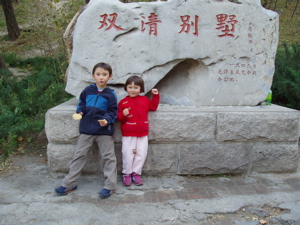
For many years, now, my answer to the question “how’s your Chinese?” has been “good enough to survive, but not good enough to have interesting conversations.” I put off reporting my recent progress until I could claim a little better.
I’ve been studying Mandarin Chinese off and on for thirteen years — since my first date with Wen. Wen has taught me a lot, especially pronunciation. I also took two semesters of Chinese during grad school, and I’ve had opportunities to practice when visiting China or when my in-laws visit us in the U.S.
Learning any language must be challenging, but Chinese seems especially difficult at first. Unlike most languages, spoken Chinese relies heavily on tone: tahng sang as a sustained note means soup, but tahng with an upward inflection (as if you’re asking a question) means sugar. The good news is that the consonants and vowels of Mandarin are relatively easy to pronounce, and there are fewer distinct sounds than in English. But then the news is bad again: most consonants appear only at the beginning of a syllable, and not all combinations of consonants, vowels, and tones sound right together, so homophones are common (even when you get the tones right). Worse, written Chinese lacks a strong connection to its pronunciation; I envy those who learn a language with a phonetic writing system.
 |
I can’t read much Chinese, and being functionally illiterate is the hardest part of living in China. For example, Ollie and Sophie’s teachers have to verbally summarize to me each note sent home from school. Similarly, when I see that the door of my office building has a sign pointing to the other door, then I go in the other door, because I can only assume that the sign applies to me. When I pick up a Chinese magazine or newspaper, I can recognize about one word out of three or four, which is rarely enough to get any idea of the content. By carefully studying the other 3/4 of a sentence, I learn essentially nothing. I also try to learn from signs on the street, but mostly I make progress through textbooks.
 | The sign says “don’t park on the sidewalk.” The cars are parked on the sidewalk. Besides the problem for pedestrians, this is not a helpful situation for someone who is trying to learn the meaning of Chinese characters through examples and context. |
For the spoken part of any language, my impression is that everyone goes through the same learning process:
It’s probably impossible to get past the “little later” and “much later” phases without regular or extended visits to a place where the language is spoken. I’m currently between the “much later” and “much, much later” phases: I can direct taxi drivers, but I’m not always sure that I understand a question.
In other words, after three months in Beijing, I’ve advanced a notch beyond survival, but I’m nowhere near interesting conversation. I answer the phone, but with some hesitation. When faced with a particular home-repair task, I can go to the store and say “You know the long kind of light? I need the things that go on the outside.” Gestures help get the problem across. The salesperson responds “You mean an electronic ballast for a fluorescent light?”, and I say “Maybe. Can you show me?” One point of this example is that you can get a long way with a small vocabulary — but it works mostly in one direction.
The other direction, listening comprehension, is the hardest part at my current stage. During my first month in Beijing, I was disappointed by how badly I could communicate. I tried learning more words and practicing pronunciation, but I eventually realized that speaking is rarely the problem; listening is the problem.
When I hear a Chinese sentence, I don’t know which words should be familiar and which are new. I don’t know where one word ends and another begins. I don’t know which word order is being used for the particular sentence. These unknowns set up a difficult parsing problem that must be solved in real time — and that’s computationally tractable only with heuristics. Of course, all language is based on such heuristics, and our brains are wired for learning them. Even better, learning seems to happen more or less automatically if you make some effort and put yourself in the right situation (e.g., by moving to Beijing). Happily, then, the language-parsing part of my brain is learning the heuristics for Chinese, and I can sense the language gradually coming into focus. But very slowly.
By the end of a year here, maybe I’ll have an easy time parsing questions. Maybe I’ll be able to understand TV shows for kids.1 Either would be much less than I originally hoped, and my 13-year head start hasn’t been as valuable as I had imagined. Naively, I thought that I might be able to start learning from TV right away, or maybe be able to read some signs on the street after a few weeks, but both of those seem impossibly difficult for now.
However far I get, one thing I’ll learn this year is an appreciation of what it takes for others to master a language. I already understand better how Wen must have felt when she moved to the U.S.
 |  |
As the year progresses, it will be interesting to see firsthand how the kids learn Chinese. I’m told that they’ll learn in a different way from me. So far, they don’t seem to have learned much — they still look to me for help! But they’re showing signs of improvement, especially in the last couple of weeks.
Ollie surprised me yesterday by understanding and answering the question “who bought that for you?” (where the correct answer was “dad”). When he meets a new person, it seems that he now resorts to “I don’t understand” as his second or third reply, instead of his first and only reply. He communicates well enough at school to get along with kids and interact with his teachers, but the few interactions I see are relatively shallow and limited by language.
Sophie doesn’t talk to strangers, whether in Chinese or English, so her progress is more difficult to gauge. She apparently still tries to talk to her classmates in English, and it looks like she doesn’t understand much of what they say back. But in the last few weeks, she’s started asking a lot of “how do you say ... in Chinese?” questions. None of the answers ever seem to come back out of her mouth, and at first she’d ask for the same words over and over. More recently, her queries seem less repetitive, so maybe the answers are getting filed away somewhere.
I’ll report again on our progress again after a few months. For now, the kids and I will continue to watch Chinese cartoons undistracted by dialogue or plot.
| 1 | Most cartoons have simpler vocabularies but more difficult accents, because all the characters talk like cartoon characters. |
| Prev: Food: The Restaurant Scene | Contents: A Year in China: 2006-2007 | Next: Guangzhou and Guilin |